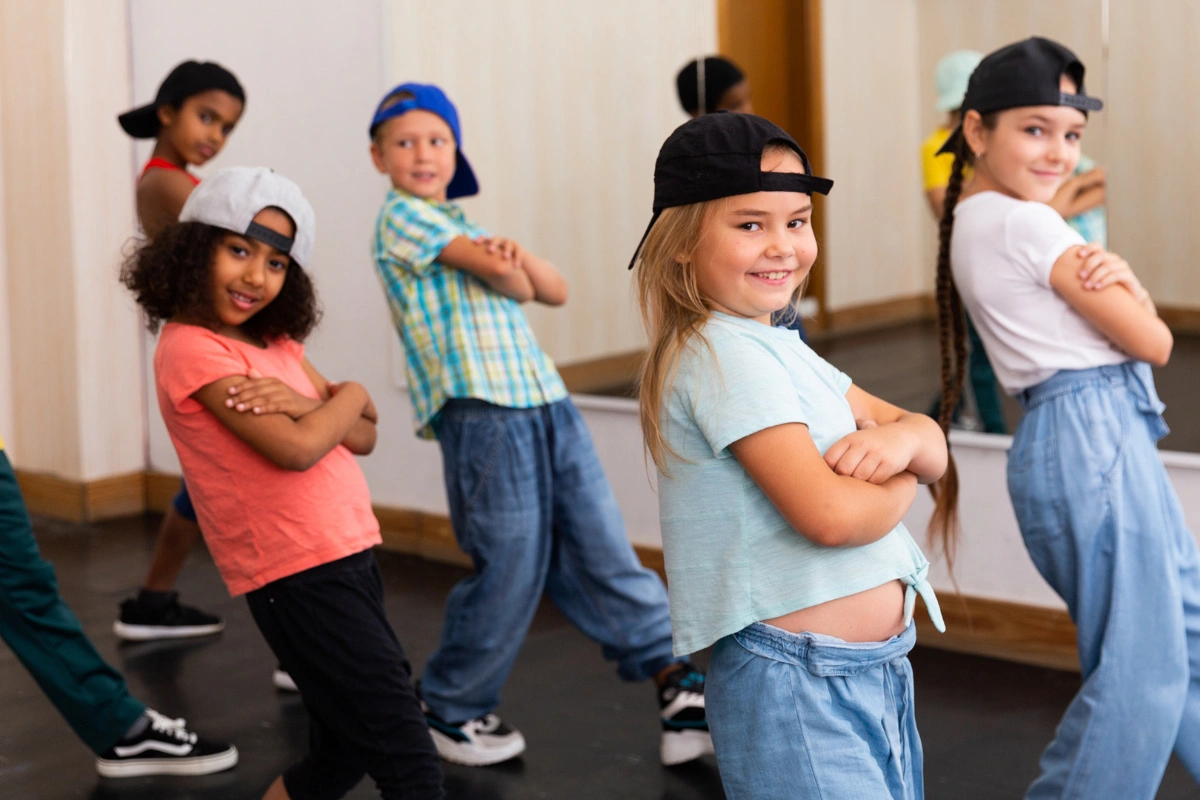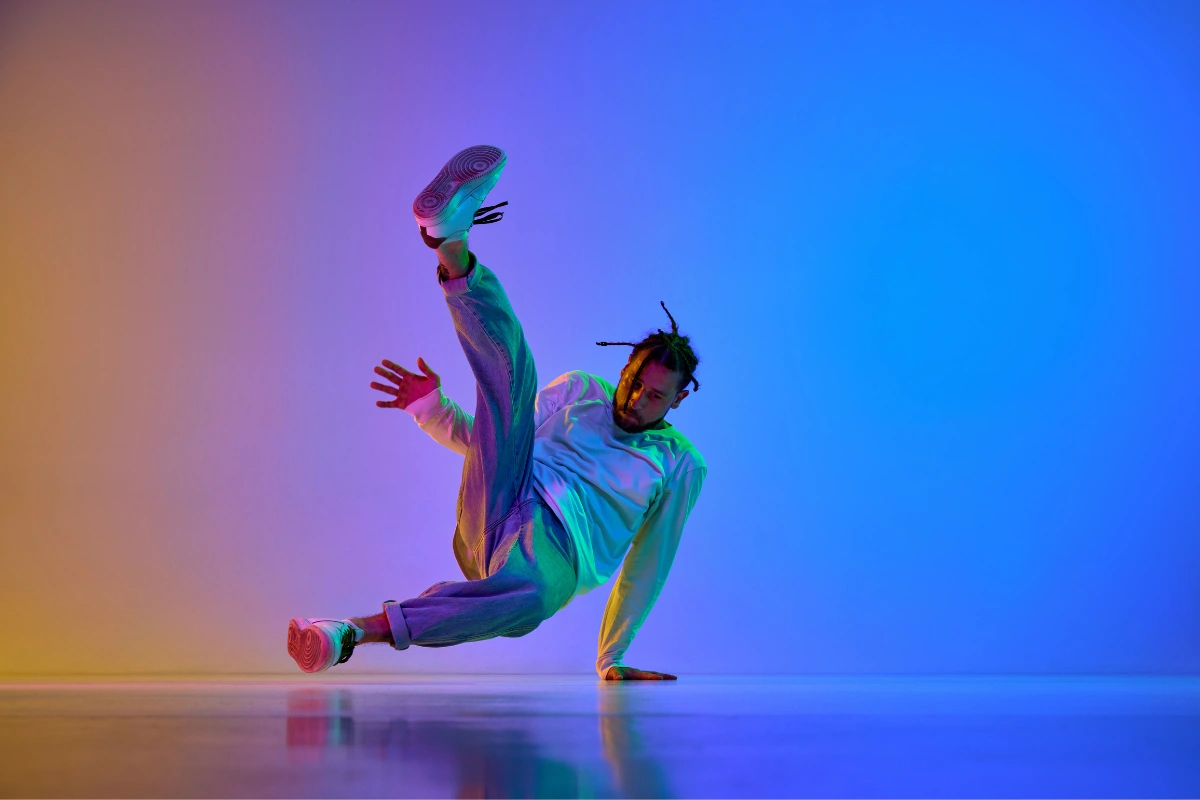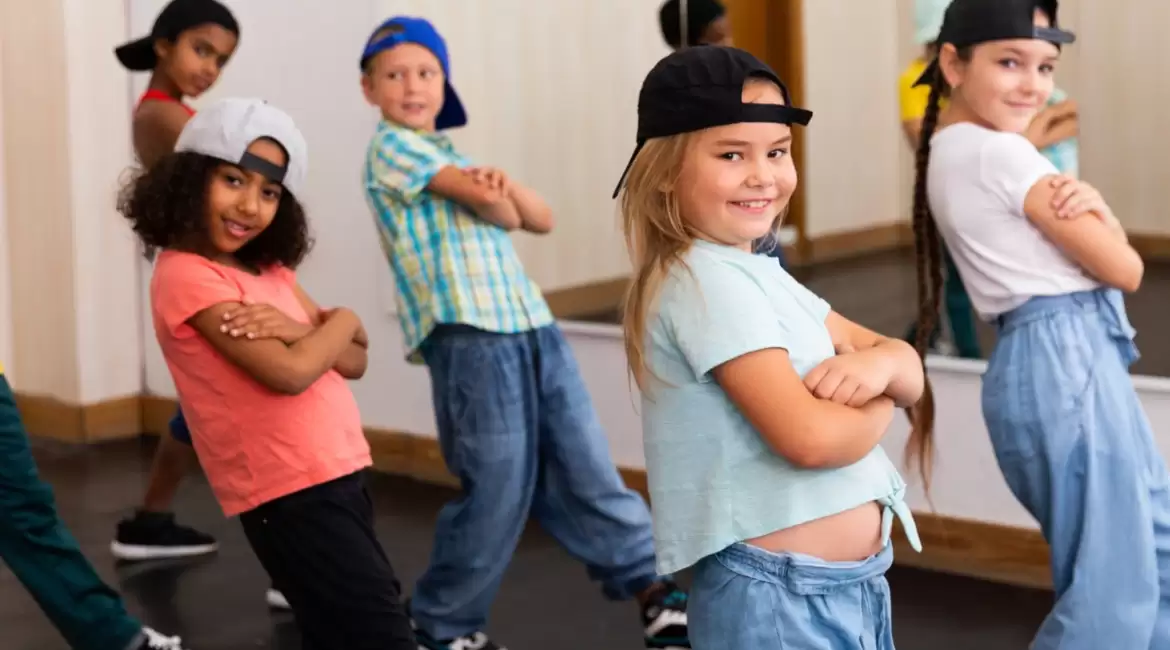Welcome to “Dance Terms Every Beginner Dancer Should Know (Part 1)“! Delving into the world of dance is an exhilarating adventure, but understanding dance terminology can sometimes feel like learning a new language. In this series, we’ll break down essential dance terms, providing clear explanations and practical examples to help you build a strong foundation for your dance journey. Whether you’re just starting out or looking to enhance your skills, this series will be your trusted guide to mastering the language of dance and unlocking your full potential as a dancer. Let’s dive in and explore the exciting world of dance together!
8-Count
The 8-count is a fundamental way to break down and count music in the context of dance. It involves counting music in a series of eight beats, which is particularly common in many dance routines. Typically, most dances are choreographed to sequences of 8 counts at a time. This structure consists of two consecutive measures of 4 counts each. By using 8 counts, dancers and choreographers can more easily organize and synchronize movements to the rhythm and flow of the music, creating a cohesive and fluid performance. This method of counting is essential for understanding the timing and coordination required in various dance styles.

Ball Change
The ball change is a fundamental dance move that consists of two steps. It involves shifting your weight from one foot to the other, either behind or next to the other foot. Essentially, you are just taking two steps in succession, making it a simple yet versatile movement that can be incorporated into various dance routines.
The kick ball change is a variation of the basic ball change. As the name implies, this move begins with a kick or a scuff of your foot, followed immediately by the two-step ball change. The kick adds an extra element of style and flair, making the overall move more dynamic and visually interesting. This variation is commonly used in many dance styles to add emphasis and rhythm to a routine.
Bass
In music, the term “bass” refers to the lowest of the standard four voice ranges, which include bass, tenor, alto, and soprano. The bass voice is known for its deep, rich tones and often serves as the foundation in vocal arrangements. Additionally, in the context of musical compositions, the bass line is the lowest melodic line that underpins and supports the harmony of the piece.
Various instruments are capable of producing bass sounds, contributing to the depth and resonance of the music. Common bass-producing instruments include bass guitars, double basses, and certain types of drums, such as the bass drum. In dance, the deep, resonant sound of a bass drum is frequently mimicked by dancers using the onomatopoeia “boom” to describe its powerful impact. This term helps dancers internalize the rhythm and timing of the music, allowing them to synchronize their movements to the beat.

Cypher
A cypher is a gathering where a group of danDancecers form a circle and take turns performing in the center. This practice, also known as a freestyle circle, is a dynamic and communal aspect of dance culture where participants showcase their individual styles and skills.
The concept of the cypher, also spelled cipher or simply referred to as a circle, holds deep and long-standing cultural significance. It is rooted in hip hop culture, where it serves as a platform for expression, creativity, and community bonding. Beyond hip hop, the cypher has connections to African traditions, where communal circles are a fundamental part of dance and social interaction. Additionally, cyphers can be linked to certain religious beliefs and rituals, where circular formations symbolize unity, continuity, and spiritual connection. The cypher, therefore, is not merely a dance practice but a cultural and historical tradition that embodies the essence of community and shared experience.
Dynamics
Dynamics in dance refer to the various ways movements are executed, influenced by the distribution and intensity of energy. The dynamics of a dance piece encompass the variations in speed, force, and flow, contributing to the overall expressiveness and visual impact of the performance.
The effectiveness of dynamics relies on how energy is managed and released throughout the movements. For instance, a dancer might execute a series of sharp, rapid movements followed by slow, fluid transitions. These contrasts in dynamics create a sense of drama and interest, making the choreography appear more engaging and lively.
Incorporating a wide range of dynamic qualities is essential for a compelling performance, as it adds depth and texture to the dance, allowing for emotional expression and storytelling through movement.

Focus
In dance, focus pertains to the direction of gaze maintained by the dancer during movement. It encompasses the intentional orientation of the eyes towards specific points in space, which significantly influences the quality and interpretation of the performance.
Dancers utilize various focal points to enhance their expression and engagement with the audience. These may include traditional directions such as right, left, up, and down, as well as intermediate angles commonly referred to as “45s” or diagonals, which lie between these cardinal directions. By shifting their focus between different points in the performance space, dancers can create dynamic visual compositions, guide the audience’s attention, and convey emotional nuances within the choreography.
Moreover, focus extends beyond mere eye movements; it encompasses the alignment of the body and intention of movement towards the chosen focal points. Dancers often integrate changes in focus with shifts in body dynamics, enhancing the overall coherence and impact of their performance. By mastering the manipulation of focus, dancers can imbue their movements with clarity, depth, and artistic expression, captivating viewers and enriching the narrative of the dance piece.
Freestyle
Freestyle dance is a spontaneous and improvisational form of movement expression where dancers have the freedom to showcase their individual style without adhering to pre-planned choreography. It is a dynamic and fluid process characterized by the creation of movements in the moment, driven by the dancer’s creativity, intuition, and emotional impulses.
In freestyle dancing, performers are not constrained by predetermined steps or sequences. Instead, they rely on their instincts and imagination to generate movement that is authentic and personal. This process of spontaneous creation allows dancers to explore new avenues of expression, experiment with different rhythms and dynamics, and fully immerse themselves in the joy of movement.
Furthermore, freestyle dance is not only about the physical execution of movements but also about connecting with the music, the environment, and the audience on a deeper level. Dancers draw inspiration from the sounds and rhythms of the music, responding intuitively to its nuances and intricacies. This symbiotic relationship between music and movement enhances the improvisational nature of freestyle dance, creating moments of spontaneity and synchronicity that are both captivating and exhilarating to witness.
Fundamentals
In the realm of hip hop culture, the term “fundamentals” encapsulates the core elements or pillars upon which the culture was built. Originating in the vibrant streets of New York City during the 1970s, these fundamentals are regarded as the foundational components that define and shape hip hop culture.
The four pillars of hip hop culture are Emceeing, DJing, Graffiti, and Breaking. Each of these pillars represents a distinct aspect of hip hop expression and creativity. Emceeing, also known as MCing, involves verbal storytelling and lyrical prowess, often delivered with rhythmic flow over beats. DJing encompasses the art of mixing and blending music, using turntables and other equipment to create dynamic soundscapes and energizing rhythms. Graffiti, as a visual art form, involves the creation of elaborate and expressive designs on public surfaces, serving as a form of self-expression and social commentary. Breaking, also known as breakdancing, is a dynamic and acrobatic style of dance characterized by intricate footwork, spins, and power moves, originating from street dance battles and parties.
Moreover, fundamental or foundational styles in dance refer to the diverse range of movement vocabularies that have emerged from hip hop, street, and funk traditions. These styles include Breaking, Popping, Locking, House, Punking/Waacking, Vogueing, and many more. Each style carries its own unique history, techniques, and cultural significance, contributing to the rich tapestry of hip hop and urban dance culture. These foundational styles serve as the building blocks upon which dancers develop their skills, creativity, and individuality, while also honoring the legacy and heritage of hip hop movement.

Full Out
“Dancing full out” entails performing with an unwavering commitment and dedication, channeling 100% of one’s energy, passion, and focus into the execution of movement and expression. It transcends mere physicality, encompassing an immersive and intense engagement with the music, the audience, and the emotions evoked by the performance.
When a dancer commits to dancing full out, they embrace the moment with a wholehearted enthusiasm and authenticity, leaving no reserves behind. Every movement is imbued with intentionality and purpose, every gesture infused with emotion and conviction. This level of commitment requires not only physical stamina and technical proficiency but also mental fortitude and emotional vulnerability.
Furthermore, dancing full out extends beyond the boundaries of the physical body, resonating with the spirit and essence of the performer. It is a manifestation of artistic expression and personal truth, a testament to the dancer’s dedication to their craft and their unwavering pursuit of excellence.
Groups
In the context of dance classes or rehearsals, the concept of “groups” entails dividing the participants into smaller, manageable sections, with each group taking turns performing a piece while the remaining students observe. This practice not only facilitates the organization and management of larger classes but also offers valuable opportunities for learning, collaboration, and growth.
Participating in groups can be an intimidating experience for dancers, especially when faced with the pressure of performing in front of peers. However, it is precisely this element of challenge and discomfort that makes group work an integral part of personal and artistic development. By pushing oneself outside of the comfort zone and embracing the opportunity to perform in front of others, dancers can cultivate resilience, confidence, and stage presence.
Moreover, groups provide a supportive and collaborative environment where dancers can learn from each other, exchange feedback, and refine their skills through observation and emulation. This peer-to-peer learning fosters a sense of camaraderie and solidarity within the dance community, encouraging mutual growth and improvement.
Furthermore, participating in groups allows dancers to develop essential performance skills such as timing, spatial awareness, and adaptability to different performance conditions. By experiencing the dynamics of group performance firsthand, dancers gain valuable insights into the nuances of ensemble work and the importance of teamwork in achieving artistic excellence.
Hi-Hat
The hi-hat is a fundamental element of percussion in music, produced by the striking of a pair of cymbals with a foot pedal. It creates a distinctive sound characterized by its sharp and crisp quality, often described by dancers as “tss tss~”.
In musical terms, the hi-hat serves multiple functions within a rhythm section. It provides a steady pulse or groove, typically playing on the off-beat to complement the primary rhythm established by the bass and snare drums. Additionally, the hi-hat can be manipulated to produce various articulations, including closed, open, and partially open sounds, offering versatility and dynamic range to the overall sound palette.
In the context of dance, the sound of the hi-hat is frequently used as a rhythmic reference point, guiding dancers in their movements and syncing their choreography with the music. Dancers often incorporate the rhythmic patterns and accents of the hi-hat into their routines, using its crisp and percussive quality to enhance the dynamics and syncopation of their movements.
Furthermore, the hi-hat’s characteristic sound contributes to the overall texture and atmosphere of a musical piece, adding depth, intensity, and groove to the arrangement. Its versatility and expressive potential make it a vital component of various musical genres, including jazz, funk, hip hop, and electronic dance music.
Holds
In dance terminology, a “hold” refers to the deliberate act of maintaining a specific move or pose without any movement for a designated count or duration within a piece of choreography. Holds serve as pivotal moments within a dance routine, providing opportunities for dancers to emphasize key positions, convey emotions, and create visual impact through stillness and control.
During a hold, dancers focus on maintaining proper alignment, balance, and expression to effectively communicate the intended aesthetic or narrative of the choreography. The duration of a hold can vary, ranging from a single count to several beats or measures, depending on the artistic vision of the choreographer and the musical phrasing.
Holds are strategically placed throughout a dance routine to enhance its dynamics, pacing, and overall composition. They can occur at the peak of a movement to create a moment of suspense or tension, or they may serve as transitional elements between sequences to allow for seamless flow and continuity.
Moreover, holds provide dancers with opportunities to showcase their technical proficiency, strength, and control, as they must sustain challenging positions with poise and grace. By mastering the art of holding, dancers can elevate the quality and precision of their performances, captivating audiences with their precision and artistry.
Additionally, holds play a crucial role in musical interpretation, as they allow dancers to synchronize their movements with the rhythmic structure and phrasing of the accompanying music. By aligning their holds with musical accents, melodies, or lyrics, dancers can create powerful moments of synchronization and expression that resonate with viewers on both an emotional and aesthetic level.

Isolation
Isolation in dance refers to the precise control and manipulation of individual body parts while keeping the rest of the body still or minimally engaged. It is a technique that allows dancers to focus on isolating specific muscles or joints, creating distinct and articulate movements that stand out within a choreography.
During isolation, dancers concentrate on maintaining stability and control in the unaffected parts of their body while executing movement in the isolated area. This requires a heightened sense of body awareness, coordination, and muscular control to achieve precise and fluid isolations.
Isolation techniques can be applied to various body parts, including the head, shoulders, ribcage, hips, and limbs, allowing dancers to create a wide range of visually striking and expressive movements. For example, a dancer may isolate their shoulders, moving them in a fluid, circular motion while keeping the rest of the body stationary. Alternatively, they may isolate their hips, executing intricate movements such as hip rolls or isolations while maintaining stillness in the upper body.
In addition to enhancing the visual impact of choreography, isolation techniques also serve functional purposes in dance. They can be used to convey emotions, portray characters, or accentuate musical accents and rhythms. By isolating specific body parts, dancers can create dynamic contrasts, textures, and nuances within their performances, adding depth and dimension to their movement vocabulary.
Furthermore, isolation exercises are commonly used in dance training to improve body control, coordination, and flexibility. Practicing isolations helps dancers develop greater precision and finesse in their movements, allowing them to execute choreography with clarity, fluidity, and expressiveness.
Levels
In dance, “levels” refer to the vertical positioning of the body, determining how high or low a dancer’s movements occur relative to the floor. Understanding and mastering levels is essential for creating dynamic and visually engaging choreography, as it allows dancers to vary the spatial dynamics and aesthetic impact of their movements.
Low levels involve positioning the body closer to the floor, often requiring dancers to bend their knees or execute a plié. This creates a sense of groundedness, stability, and power in the movement. Low-level movements can range from deep lunges and squats to floor work and intricate footwork close to the ground.
On the other hand, high levels entail elevating the body above the floor, which may involve rising onto the toes in a releve or lifting the body upright. High-level movements create a sense of lightness, expansiveness, and elevation in the choreography. Examples of high-level movements include leaps, jumps, lifts, and extensions that extend the body upward and outward into space.
Matching levels with the choreographer or other dancers is crucial for achieving uniformity and cohesion within a group performance. Dancers can use mirrors or visual cues to ensure that they are aligning their levels with those of their peers, maintaining consistency and synchronization throughout the choreography. This attention to detail enhances the overall visual impact and professionalism of the performance, creating a unified and polished aesthetic.
Moreover, mastering levels allows dancers to explore the full range of motion and expression within their movement vocabulary. By seamlessly transitioning between high, medium, and low levels, dancers can create dynamic contrasts, textures, and rhythms in their choreography, captivating audiences with their versatility and artistry.
Summary
“Dance Terms Every Beginner Dancer Should Know (Part 1)” is a comprehensive guide designed to assist novice dancers in understanding fundamental dance terminology. The series aims to demystify the language of dance, providing clear explanations and practical examples to aid beginners in building a solid foundation for their dance journey. Through concise yet informative content, readers will explore key terms and concepts essential for communicating effectively in the dance studio and on the dance floor. From basic steps and positions to nuanced techniques and expressions, each installment of the series offers valuable insights and guidance to help beginners navigate the intricacies of dance terminology with confidence and ease. Whether readers are stepping into the studio for the first time or seeking to expand their dance vocabulary, this series serves as a valuable resource for dancers of all levels, empowering them to enhance their skills and embrace the joy of dance.


Leave a reply